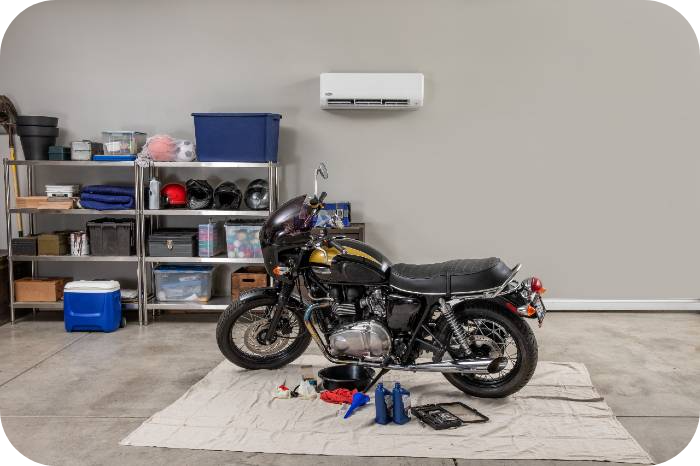Benefits Of A Ductless Air Conditioner For A Garage


The garage used to be an often-overlooked opportunity to add living space and enhance your resale value. That’s changing now that more people are homeschooling and remote working than ever before. Along with adding extra living space, it’s isolated from other rooms.
That makes it a quiet area for learning or working. But you’ll probably want the space to be more comfortable than if it were just a home gym or workshop, right?
That means adding heating and cooling. And, if you spend a lot of time in there, you need to dial in that temperature.
A ductless air conditioner in the garage is the perfect finishing touch.
You may have heard of these as mini splits, zone systems, or mini split heat pumps. They’re all the same thing and are much more than just air conditioning systems.


As a product manager for Peirce Phelps for well over a decade, I’ve seen firsthand how popular these are becoming in the mid-Atlantic states. As the technology behind them improved, today’s models can also heat a home even on the coldest winter nights.
That makes them an excellent choice for home offices, renovations, or if you need a comfort upgrade.
In this article, however, I’m concentrating on the benefits of a ductless mini split for a garage. I’ll compare it to extending ductwork from the house, weigh their pros and cons, and give you some direction about the size and specs you’ll need.
Do you have specific questions about the project you have in mind? Ese the dealer locator button below to schedule a free consultation with a certified HVAC installer in Pennsylvania, Delaware, New Jersey, or Maryland.
Mini Split For a Garage Vs. Extending Ductwork
If you already have a central HVAC system in your house, you might wonder if extending it to your garage is possible. The answer is yes, but there’s plenty to consider before making that decision. A mini split may be the better option.
Adding Ductwork
Adding ductwork from your existing HVAC system means having a professional design a run, fabricate the ducts, and run them through the walls or ceiling of your house and into the garage.
While you can still use your existing system, you’ll likely run into these problems:
Weakened Airflow
You won’t get as strong a rush of air in the garage as you do in other parts of the house. Those other areas will likely suffer, too.
That’s because your existing system was sized for the square footage it’s been covering. When you add more space, you dilute the heating and cooling potential for the whole house.
Bad Temperature Control
Since the thermostat is inside, you never get a gauge of how hot or cold the garage is. And, since it’s not as insulated as the rest of the house, it gets colder in the winter and hotter in the summer. But your system won’t account for that because the thermostat won’t pick up the difference.
Expensive Installation
Ultimately, it’s a lot of expensive, intrusive, and time-consuming construction work. Things get really complicated if obstacles like plumbing or electrical wiring are in the way.
Can I Put a Mini Split In My Garage?
A mini split is easy to install in a garage. With a wall mount air handler on an exterior wall, it’s fast and easy for an installer to run a line set from there to an outdoor unit. They work well in open spaces like this, and are Energy Star-certified to save money on utility bills.
Advantages Of A Ductless Mini Split Air Conditioner In a Garage
Adding a single-zone mini split unit in the garage with an outdoor heat pump is a popular alternative to adding ductwork. It costs less and provides more benefits, including:
Customized Heating and Cooling
The air handler on a ductless mini split system has a built-in thermostat. It lets you set the temperature for the garage separately from the rest of the house.
Easy Installation
Ductless mini split air conditioners don’t require any ductwork, so installation is fast and easy. All your contractor has to do is mount the heat pump outside and the air handler inside. Then, they run the refrigerant line and power supply through the wall to connect them. It takes less than a day.
Energy Efficiency
Mini splits use inverter technology to regulate the compressor speed based on the current demand for cooling or heating. They consume less energy than traditional HVAC systems as a result.
As a result, your energy bills won’t change much once you start running your new system. If you’ve used space heaters and window ACs previously, you’ll pay less than before.,
How To Determine What Size Mini Split For A Garage
A mini split system’s size and capacity are crucial to ensure maximum efficiency and performance. You’ll need a certified contractor to perform a professional load calculation to account for all the factors. But you can use these estimates to start:
One-Car Garage
I recommend a mini-split system with a BTU rating ranging from 6,000 to 9,000 BTUs for a one-car garage. It’s enough for cooling and also heating in the winter.
Two-Car Garage
A mini-split system from 12,000 to 18,000 BTUs is best for a two-car garage.
Three-Car Garage
You may need a multi-zone system for a three-car garage. It’s a lot of open space, and one air handler usually needs to be stronger to circulate the air far enough. Two indoor units should be enough. Or, in some cases, a recessed ceiling cassette can do the job.
Cost to Install a Garage Mini Split
Expect to pay between $3,000 and $4,000 for a to install a mini split in the garage. That’s for a single-zone, and the the price goes up with additional air handlers. While that’s much more than portable heating and cooling, it’s less than extending ductwork. A split system will do a better job than either of those options.
FAQs
Those are the basics of a mini split air conditioner for a garage, and I’ll answer a few more FAQs here. If you have more specific questions, check out our dealer locator to find a certified contractor for a free consultation.
Can You Put an Air Conditioner in a Garage?
An air conditioner can be used in a garage. While adding ductwork for central air is usually not window AC units, portable air conditioners, and ductless mini-split systems all work well. The type of air conditioner that you choose will depend on your garage size and cooling needs.
Do Ductless Mini Splits Use a Lot of Electricity?
Ductless mini-split systems are known for their high efficiency and energy-saving capabilities. They use less electricity than traditional HVAC systems because they don’t have ductwork, which can cause energy loss. The amount of electricity a ductless mini-split system uses will depend on its size and SEER rating.
How Many Square Feet is a Mini Split Good For?
As a rule of thumb, a 9,000 BTU mini-split unit cools up to 400 square feet. A 24,000 BTU unit cools up to 1,500 square feet. These measurements are also affected by the room’s insulation, window placement, and other factors.
Ductless Carrier can help you find the perfect ductless air conditioner installer in Philadelphia, PA or anywhere in Pennsylvania, New Jersey, Maryland, or Delaware.